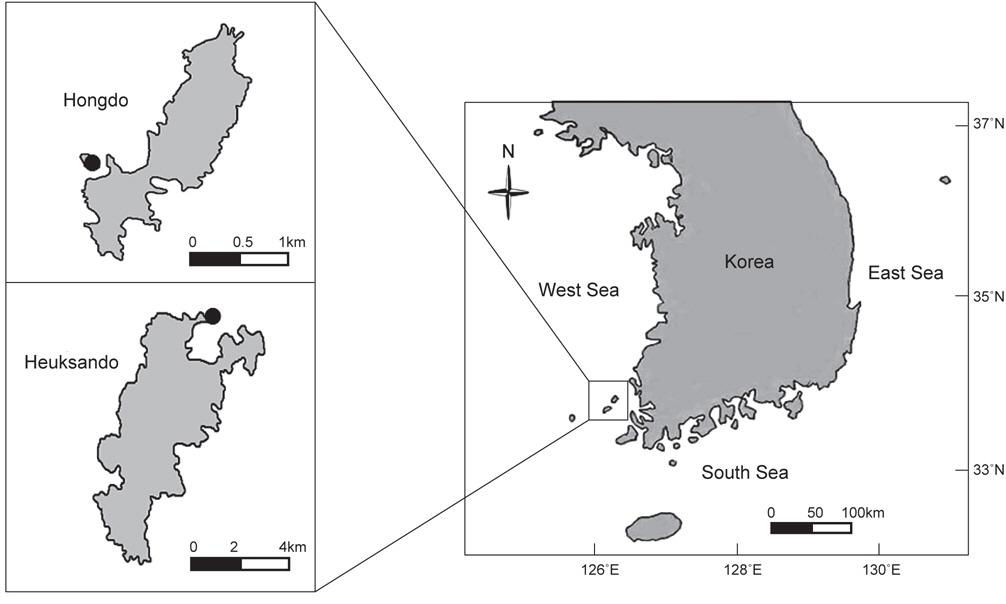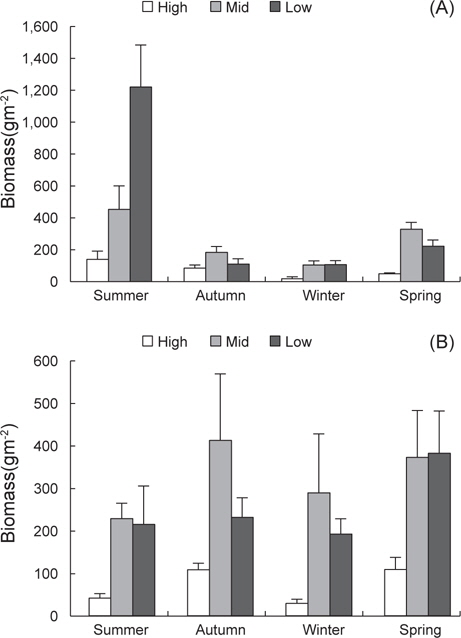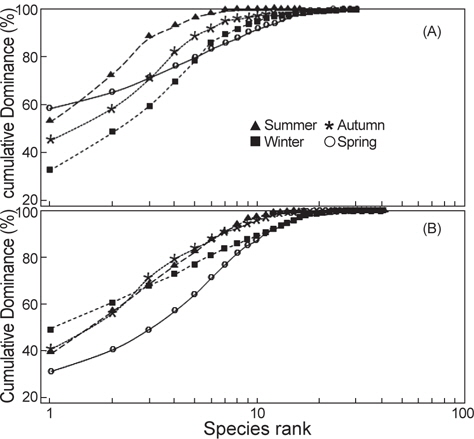



Seasonal variation in marine macroalgal community structure was examined at the intertidal zones of Heuksando and Hongdo, Shinan, Korea, from July 2008 to May 2009. In total, 86 macroalgal species were identified, including 12 green, 19 brown, and 55 red algae; 67 species at Heuksando and 70 species at Hongdo, were observed. Annual seaweed biomass was 252.44 g dry wt/m2. at Heuksando and 217.67 g dry wt/m2 at Hongdo. The dominant seaweed in importance value (IV > 15) differed between the sites:
해양생태계에서 일차생산자의 중요한 구성원의 하나인 해조류는 무척추동물과 척추동물의 산란장과 섭이장 그리고 포식자에 대한 은신처뿐만 아니라, 부착 동·식물에게는 착생기질로 이용되므로 해양생물의 종다양성과 생산성을 증대에 일조한다(Lindstrom, 2009). 온대해역의 해조류 군집구조는 계절적으로 변화하는 수온, 염분 및 광주기 등 무생물적 환경요인(Lobban and Harrison, 1997)과 경쟁과 섭식압 등의 생물학적요인, 그리고 인간의 직·간접적 활동(부영양화, 퇴적물의 증가 등)에 따라 변화한다(Tribollet and Vroom, 2007). 특히, 인간활동에 기인한 환경오염이나 부영양화가 발생한 해역에서는 해조류의 종 다양성이 낮고 단순화된 군집구조를 가지는 것으로 알려져 있어 해조상과 군집구조로 생태계의 환경변화를 예측 혹은 진단 할 수 있어 생물학적 지시자(biological indicator)로 사용된다 (Díez et al., 1999; Wells et al., 2007).
우리나라 전라남도 연안은 해안선의 굴곡이 심하고 다양한 크기의 많은 섬들로 구성되어 있을 뿐만 아니라, 해류, 수온, 수심과 탁도의 변화가 매우 심한 해황적 특성을 보인다(Kang, 1966; Choi, 1992). 전라남도 해역에서 해조류 연구의 시초는 정약전이 1814년에 집필한 자산어보에서 흑산도에 35종이 출현한 것으로 기록되어 있는 것이며, 해조학자인 Kang (1966)은 한국산 해조류의 지리적 분포를 구분하면서 대흑산도와 소흑산도에서 89종이 생육하는 것을 보고하였다. 이후 Lee et al. (1986a)은 대흑산도와 소흑산도를 포함한 6개 섬의 하계 조사에서 129종을 기재하였고 Kang (1966)의 연구 결과와 비교하여 이곳에 서식하는 해조류는 총 160종으로 기록하였다. 이외에도 홍도와 흑산도가 포함된 행정구역인 신안군의 우이도의 계절별 조사에서 139종(진리 76종, 성촌 124종)이 관찰되었으며(Choi et al., 1994), 도초군도의 무인도서 15개의 하계조사에서 53종(Park et al., 2007)과 신안군의 3개면(압해, 자은, 암태면)의 인근 무인도서 16개의 하계조사에서 63종을 기재하였다(Oh et al., 2005). 홍도와 흑산도는 육지와 멀리 떨어진 유인도로서 연구를 위한 접근성 및 비용이 많이 들어 지금까지 계절적인 군집 구조 및 생물량 변화에 대한 연구가 수행되지 않았다.
Kang (1966)은 우리나라 연안의 해조류의 지리적 분포를 동해안 북부, 동해안 중남부, 남해안(울릉도 포함), 서해안, 제주도의 5개구(section)로 나누면서 흑산도와 홍도를 남해안의 서쪽 북방한계선이라고 하였다. 20여년이 지난 80년대 중반에는 남해구와 서해구의 경계에 있는 소흑산도와 추자군도를 제주구로 포함시킬 것을 제안하였다(Lee et al., 1986a, 1986b). 이외에도 해조학자들은 녹조류가 열대해역, 갈조류가 한대해역, 홍조류가 온대해역에서 많이 출현한다는 사실을 근거로 하여 분류군별 출현종수를 이용한 갈조류에 대한 녹조류의 비(C/P), 갈조류에 대한 홍조류의 비(R/P), 갈조류에 대한 녹조 및 홍조류의 비로 (R+C)/P를 이용하여 조사해역의 해조상의 특징을 파악하려고 하였다(Feldmann, 1937; Segawa, 1956; Cheney, 1977). 특히, (R+C)/P 의 비율은 Cheney (1977)의 비율로 회자되면서 해 조상의 특성(한온대, 온대, 열대)을 나타내기 위하여 우리나라의 수많은 해조류 생태학자들과 유럽의 학자들에 의해 사용되어 왔다(Van Den Hoek, 1975; Kapraun, 1980; Bolton, 1986; Garbary, 1987; Schils and Coppejans, 2003).
본 연구는 우리나라 해조류의 지리적 분포에 매우 중요한 경계지역인 서남해안 흑산도와 홍도 연안의 해조류 군집의 특성을 파악하기 위하여 해조상, 우점종, 수직분포와 생물량의 계절적 변화양상을 밝히고자 하였다. 또한, 연구해역을 중심으로 한 다양한 섬에서 수행된 Cheney (1977)의 값들의 비교 및 해석을 시도하였다.
전남 신안군에 위치한 흑산도와 홍도 해역에서 2008년 7월부터 2009년 5월까지 계절별로 최 간조기에 해조류를 정량 및 정성 채집하였다(Fig. 1). 조간대 상, 중, 하부에 각 5개의 방형구(50 cm×50 cm)를 무작위적으로 놓고 Saito and Atobe (1970)의 방법에 따라 피도와 빈도를 기록한 후에 방형구내의 해조류를 전량 채집하였다. 또한, 홍도와 흑산도의 해조류 출현종을 파악하기 위하여 조간대의 다양한 기질과 조위에서 서식하는 모든 해조류를 정성 채집하였다. 채집된 해조류는 포르말린-해수용액(5-10%)으로 현장에서 고정시켜 실험실로 운반한 후 현미경을 사용하여 분류 및 동정하였으며, 출현종 목록 및 국명은 Lee and Kang (2002)에 따랐다.
정량 채집된 해조류는 담수로 수회 세척하여 모래와 불순물을 제거하고, 동정한 후 60 ℃로 설정된 건조기에서 7일 동안 건조하여 건중량을 측정하였고 단위면적당 생물량(g m-2)으로 환산하였다. Saito and Atobe (1970)의 방법에 의해 피도, 빈도, 상대피도와 상대빈도는 계산하였고, 중요도(importance value, IV)는 상대피도와 상대빈도의 평균값이다(Mueller-Dombois and Ellenberg, 1974). 정성 채집된 해조류를 분류 및 동정한 후에 해조상의 특성을 파악하기 위하여 갈조류에 대한 녹조류의 비(C/P), 갈조류에 대한 홍조류 비(R/P), 갈조류에 대한 녹조 및 홍조류의 비로(R+C)/P가 계산되었다(Feldmann, 1937; Segawa, 1956; Cheney, 1977). 또한, 정점별 출현종과 생물량 자료를 이용하여 풍도지수(richness index, R), 다양도지수(diversity index, H')와 균등도지수(evenness index, J')를 계산하 였다(Margalef, 1958; Fowler and Cohen, 1990). 우점도지수(dominance index, DI)는 군집 내에서의 생물량 순서에 따라 제1, 2 우점종을 선택하고 2종의 생물량 합에 대한 총 생물량의 비율로 산출하였다(McNaughton, 1967; Lee et al., 1983). 해조류의 생물량으로 K–dominance 곡선을 그렸으며(Lambshead et al., 1983), 군집지수의 산출 및 도식화에는 PRIMER version 6 (Clarke and Gorley, 2006)을 사용하였다.
본 연구기간에 신안군 흑산도와 홍도의 해역에서 출현한 해조류는 총 86종(녹조 12종, 갈조 19종, 홍조 55종)이었으며, 홍조류의 출현종수가 63.95%를 차지하였다(Table 1). 흑산도에서는 계절별로 31-41종이 관찰되었고 연구기간에는 67종이 출현하였으며, 홍도에서는 27-41종으로 총 70종이 기록되었다(Table 1). 흑산도와 홍도 두 해역에서 연중 관찰되는 해조류는 톳(
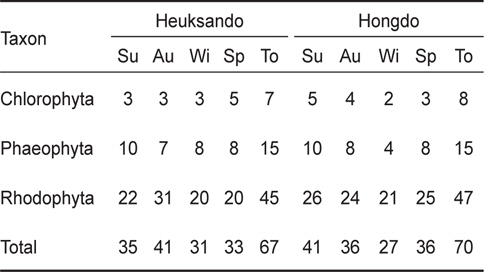
The number of macroalgal species observed at Heuksando and Hongdo, South-Western coast of Korea (Su, Summer; Au, Autumn; Wi, Winter; Sp, Spring; To, Total)
흑산도와 홍도 연안에 서식하는 해조류의 연평균 생물량(g dry wt/m2)은 235.06 g /m2 였으며, 흑산도 해조류의 계절별 생물량은 77.40-604.68 g/m2 (연평균, 252.44 g/m2)이고 겨울에 최소이고 여름에 최대로서 계절적 변동이 나타났다(Fig. 2). 홍도해역에서 해조류 생물량은 연평균 217.67 g/m2이었고 계절별로 161.76-287.95 g/m2 로서 여름에 최소였고 봄에 최대 였다(Fig. 2). 조위별 생물량은 흑산도 조간대 상부에서19.08– 139.40 g/m2, 중부에서 105.41-453.59 g/m2, 하부에서 107.70- 1,221.04 g /m2로 조위가 낮아질수록 증가하는 패턴을 보였다. 홍도 조간대 상부에서 생물량은29.40-109.34 g/m2 (평균 72.13 g/m2), 중부에서 229.04-412.36 g/m2 (325.84 g/m2), 하부에서 192.00-381.95 g/m2 (255.05 g/m2)로서 상부에서 가장 낮았고 중부에서 최대였다(Fig. 2).
해조류 생물량과 종다양성을 근거로 도식화된 K–dominance 곡선을 보면, 흑산도에서 여름에 우점하는 해조류는 지충이 (322.00 g/m2, 53.25%)와 톳(110.66 g/m2, 18.30%)으로 2종이 전체 생물량의 71.55%를 차지하였고, 가을에는 지충이와 작은 구슬산호말이 158.85%, 겨울에는 제 1우점종인 지충이(25.69 g/m2, 33.19%)와 제 2우점종인 참모자반의 생물량 합이 37.82 g/m2(전체 생물량의 48.87%)이었다. 또한, 흑산도에서 봄에는 지충이(118.62 g/m2, 58.98%)와 참보라색우무(13.75 g/m2, 6.84%)가 주요종이었고 해조류의 종다양성은 겨울에 최대 여름에 최소로 나타났다(Fig. 3A). 홍도에서는 제 1과 제 2우점종을 보면, 여름에는 지충이(64.15 g/m2, 39.66%)와 톳(28.77 g /m2, 17.79%), 가을에는 작은구슬산호말(102.09 g/m2)과 톳(39.94 g/m2)으로 전체 생물량의 56.33%를 차지하였고 겨울에는 작은구슬산호말(50.15%)과 지충이(11.13%), 그리고 봄에는 작은구슬산호말(32.14%)과 불레기말(25.38 g/m2, 8.82%)로 확인되었다(Fig. 3B).
해조류의 상대피도와 상대빈도로 계산한 중요도(IV)를 근거로 조간대의 조위별 우점종을 보면, 흑산도에서 지충이(17.60)가 모든 계절에 조간대 상부에서 하부까지 고르게 출현하며 높은 중요도 값을 보여 대표종이었으며(Table 2), 수직분포는 김·지충이·파래류·풀가사리류(상부) – 지충이·톳·진분홍딱지·개서실(중부)–지충이·톳·작은구슬산호말·개서실·참보라색우무·구멍갈파래(하부)로 나타났다. 한 계절에만 우점하는 종은 여름에 조간대 상부의 바위수염과 불등풀가사리(
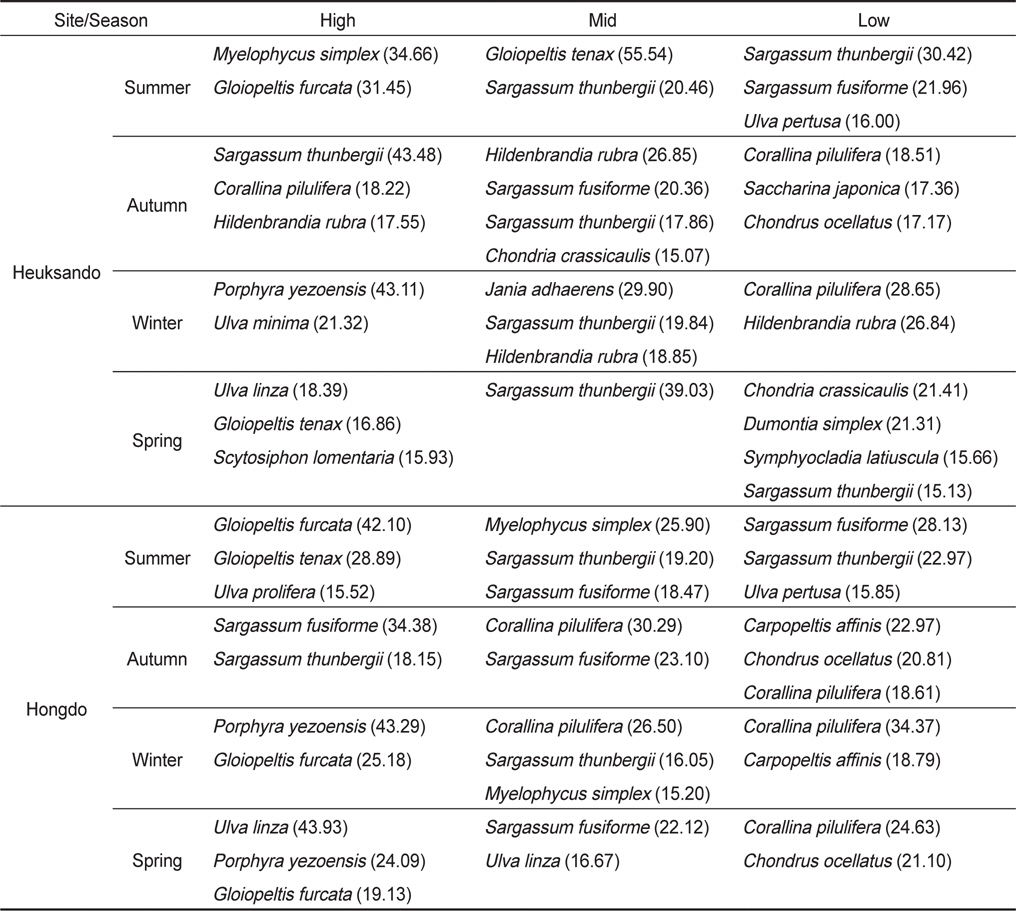
Seasonal vertical distribution of dominant seaweeds (IV>15) growing on the intertidal rocky shores of Heuksando and Hongdo, South-Western coast of Korea
홍도에서 중요도 값에 근거한 대표종은 작은구슬산호말(14.88)이었으며, 수직분포는 풀가사리류·갈파래류·김류·지충이(상부) – 작은구슬산호말, 톳, 지충이, 바위수염(중부) – 톳, 지충이, 진두발, 작은구슬산호말, 까막살(하부)로 확인되었다(Table 2). 특정 계절에만 번무하는 종으로는 여름철 조간대 상부에서 서식하는 참풀가사리(
해조류의 연평균 피도는 흑산도에서 31.54% (계절별, 26.29- 35.71%)이고 홍도에서 41.35% (계절별, 31.74-64.14%) 였으며(Table 3), 생물량과 출현종수로 계산된 연평균 군집지수는 흑산도에서 제 1, 2 우점종이 지충이(130.81 g/m2)와 톳(34.25 g/m2)으로 전체 생물량(252.44 g/m2)의 65.39%를 차지하여 우점도 지수(DI)가 0.65였으며, 홍도에서 작은구슬산호말(73.26 g/m2)과 지충이(35.48 g/m2)가 49.96%를 차지하여 0.50으로 나타났다. 4계절 출현종수와 평균 생물량값을 이용한 풍도지수(R)는 흑산도에서 11.93 (계절별, 5.31-8.06)과 홍도에서 12.82(계절별, 5.06-7.86)로서 계절별 변화에 비해 훨씬 높게 나타났으며, 균등도지수(J')는 제1우점종(지충이)이 52%를 차지한 흑산도(0.44)에 비해 출현한 해조류의 생물량이 균등하게 분포한 홍도에서 0.59로 높았다. 다양도지수(H')는 흑산도에서 1.87이고 홍도에서 2.50로 나타났다.

Average biomass (g dry wt/m2), percent cover (%), and various community indices of seaweeds at Heuksando and Hongdo, South- Western coast of Korea (Sp, Spring; Su, Summer; Au, Autumn; Wi, Winter)
해조상의 지역적 특성을 나타내는 C/P값은 흑산도에서 0.30-0.63의 범위로 여름에 최소, 봄에 최대를 보였으며, 홍도에서 0.38-0.50의 범위로 봄에 최소였고 여름에서 겨울까지 0.50으로 동일하였다. R/P값과 (R+C)P값은 흑산도에서 2.20-4.43, 2.50-4.86의 범위로 여름에 최소 가을에 최대를 보였고, 홍도에서는 각각 2.60-5.25, 3.10-5.75의 범위로 여름에 최소 겨울에 최대값을 보였다. 흑산도와 홍도의 연평균 C/P, R/P, (R+C)/P값을 보면 갈조류의 비율이 많은 흑산도에서 모두 낮게 나타났다(Table 3).
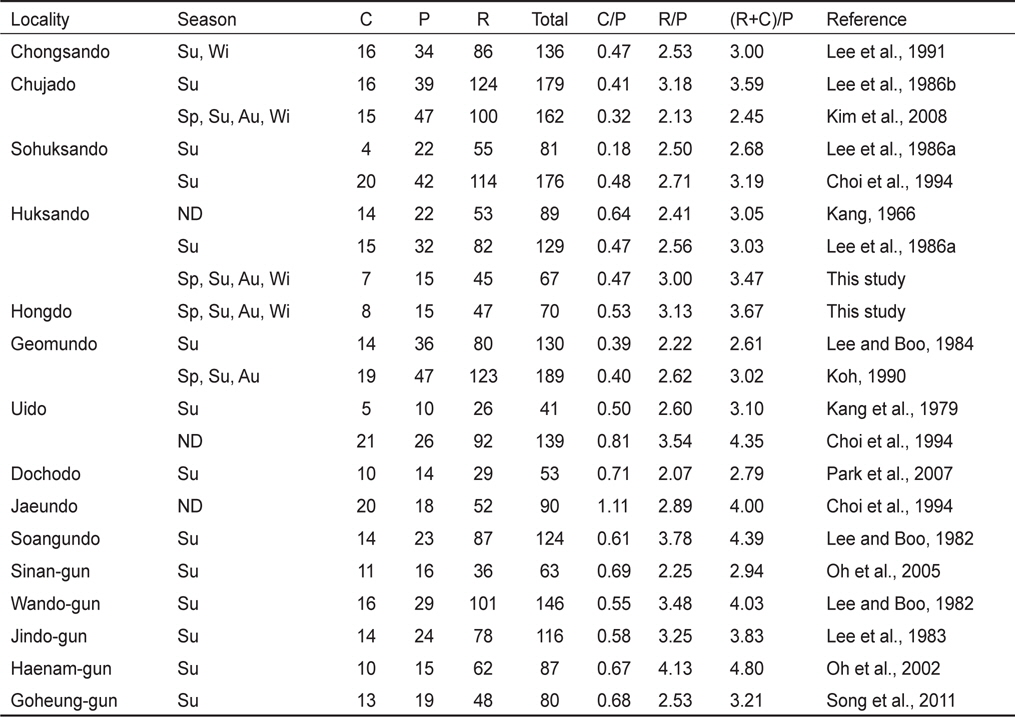
Floristic comparisons of marine seaweeds for several localities in South-Western coast of Korea (Sp, Spring; Su, Summer; Au, Autumn; Wi, Winter)
본 연구 지역인 흑산도와 홍도에서 동정된 해조류는 86종 (녹조 12종, 갈조 19종, 홍조 55종) 이었으며, 인근 해역의 해조류 출현종수와 비교하여 보통 수준이었다(Kang, 1966; Uhm, 1968; Kang et al., 1979; Lee et al., 1986a; Choi et al, 1994). 이전의 연구에서는 Kang (1966)이 대흑산도와 소흑산도에서 89종, Lee et al. (1986a)은 흑산도와 소흑산도를 포함한 6개 섬의 하계 조사에서 129종을 기재하였다(Table 4). 홍도에서는 동계에 24종(Uhm, 1968), 우이도와 매섬에서 하계에 65종(Kang et al., 1979), 우이도에서 112종(Choi et al., 1994), 하태도에서 112종(Oh and Lee, 1989), 그리고 진도에서는 116종이 기록되었다(Lee et al., 1983). 이외에도 서남해안에 위치한 섬인 자은도에서92종, 조도군도에서 114종, 소안군도에서 124종이 출현 하였다는 기록이 있다(Choi et al., 1994). 최근 10년 이내의 연구로는 신안군 도초면의 15개 무인도서의 하계 조사에서 53종(Park et al., 2007)이, 신안군 압해면, 자은면과 암태면 인근의 16개 무인도서의 하계 조사에서 63종이 출현하였다(Oh et al., 2005). Park et al. (2012)은 신안군 하의도 갯벌의 7개 정점에서 9종의 해조류가 서식하고 있다고 밝혔으며, 인근의 완도군 청산도의 3지역(당리, 진산리, 동촌리)의 조간대와 조하대에서 2계절(여름, 겨울)에 출현한 종이 136종으로 기록되었으며(Lee et al., 1991), 제주도의 추자도(예초, 후포)에서는 162종이 서식하는 것으로 확인되었다(Kim et al., 2008). Choi et al. (1994)는 우의도의 진리에서 76종, 성촌에서 124종의 해조류가 동정 되어 같은 섬이라도 탁도와 같은 미소해양특성에 따라 종다양성은 차이가 있다고 하였으며, Park et al. (2012)의 연구에서 본것처럼 연성저질인 갯벌에서는 종다양성이 현저하게 감소한다는 것을 확인할 수 있었다. 또한, 해조상은 환경의 변화와 더불어 채집 방법 및 시기가 따라 달라지기 때문에 홍도와 흑산도 해역의 해조류 종다양성에 대한 논의는 좀더 자료가 축적된 후에 논의되어야 하며 효율적인 해조자원의 관리 및 변화를 모니터링하기 위한 노력이 요구된다.
홍도와 흑산도 인근 해역의 조간대에서 해조류의 생물량은 신안군 하의도(성촌)에서 여름철에 160.46 g dry wt/m2였으며(Choi et al., 1994), 고흥군 4개섬(내매물도, 컬도, 아래돔배섬, 진지외도)에서 여름철에 21.39–76.22 g dry wt/m2 (평균 50.85 g dry wt/m2)였다(Song et al., 2011). 서해안 중부의 부안군 외조도와 주삼도 조간대에서 해조류의 연평균 생물량(계절별 조사)은 59.25 g dry wt/m2 (여름 49.83 g dry wt/m2)과 86.74 g dry wt/m2 (여름 129.56 g dry wt/m2)를 보였다(Choi et al., 2008; Heo et al., 2011). 또한, 전남 여수시 거문도 4개 정점(대삼부도, 서도, 동도, 고도)에서의 조간대와 조하대(수심 3-4m)에서 평균 생물량(봄, 여름, 가을)은 83.32-169.16 g dry wt/m2(평균 121.48 g dry wt/m2)로 기록되었으며(Koh, 1990). 본 연구지역인 흑산도와 홍도의 조간대에 서식하는 해조류의 연평균 생물량은 흑산도에서 252.44 g dry wt/m2와 홍도에서 217.67 g dry wt/m2로서 다른 해역에 비해 높게 나타났으며, 추자도(예 초, 후포)의 연평균 생물량(습중량, 425.63 g wet wt/ m2)과 비교해도 결코 낮지 않았다.
Lee et al. (1986a)은 흑산도 하계 해조류 조사에서 수직분포는 상부에서부터 불등풀가사리–바위수염–뜸부기–구멍갈파래–지충이–톳–참보라색우무–미역–다시마의 순서로 뚜렷한 구분을 보인다고 하였다. 신안군 도초군도와 신안군 3개면(압해, 자은, 암태면)에서도 불등풀가사리·애기가시덤불·패·바위수염(상부)–지충이·구멍갈파래·납작파래·참구슬산호말·진두발(중부)–참보라색우무·괭생이모자반·우뭇가사리·참도박·알쏭이모자반(하부)의 수직분포를 보였다(Oh et al., 2005; Park et al., 2007). 신안군 도초면 우이도에서는 상·중부에서 불등풀가사리· 애기우뭇가사리· 바위수염이 우점하였으며, 하부에서는 지충이·작은구슬산호말·구멍갈파래·바위수염이 번무하는 것으로 나타났다(Choi et al., 1994). 이외에도 완도군 청산도의 조간대 상부에서 불등풀가사리, 중·하부에서 작은구슬산호말·참산호말·톳·지충이가 번무하는 것으로 확인되었다(Lee et al., 1991). 본 연구지역인 흑산도에서 김·지충이·파래류·풀가사리류 ( 상부)–지충이·톳·진분홍딱지·풀가사리류 ( 중부)– 지충이·톳·작은구슬산호말·개서실·진분홍딱지 (하부)였고, 홍도에서는 풀가사리류·파래류·김류·지충이(상부)– 작은구슬산호말, 톳, 지충이, 바위수염(중부)– 톳, 지충이 진두발, 작은구슬산호말, 까막살(하부)이 번무하여 20여년 경과 후의 해조류의 수직분포는 커다란 변화가 없었으나, 흑산도에서 번무하던 뜸부기는 현재 관찰되지 않아 뜸부기의 개체군 감소는 서해안과 함께 서남해안에서도 발생하고 있음이 확인되었다.
분류군별 출현종수를 기준으로 해조류의 지리적 분포의 특징을 나타내는 C/P값은 한대해역에서 아열대해역에 걸쳐 0.4–1.5 범위의 값을 보이고(Segawa, 1956), R/P값은 한대와 극지역에서 ≤1.0이하, 온대에서 1.0–4.0, 열대해역은 ≥4.0 이상을 보였으며(Feldmann, 1937), (R+C)/P값에 따라, 온대성 내지 한대성(<3), 혼합성(3–6), 열대성(>6) 해조상으로 구분된다(Cheney, 1977). 본 연구에서는 C/P값이 0.47–0.53, R/P값은 3.00–3.13의 범위로 온대해역 해조상을 보였으며, Cheney (1977)의 비율인 (R+C)/P값은 흑산도에서 3.47이고 홍도에서 3.67로서 혼합된 해조상을 보였다. 흑산도와 홍도를 포함한 서남해안의 유인 및 무인도서의 (R+C)/P값은 모두 혼합성 해조상으로 나타났지만 시간적으로는 이전에 비해 최근 연구에서 증가한 값을 보였고, 외해에 위치한 섬에 비해 내만에 위치한 섬에서 높은 값을 보임으로써 해수온의 상승과 관련이 있는지 계속적인 관심이 요구된다. Garbary (1987)는 Feldmann과 Cheney 값은 북대서양의 해조류의 생물지리적 분포를 잘 반영하고 있다고 하였으나, Bolton (1986)은 남아프리카에서 이러한 군집지수를 이용하는 것은 한계가 있다고 밝혔으며, 이유는 해류와 용승류의 영향을 받기 때문이라고 하였다. 또한, Kapraun (1980)은 북 대서양의 한온대역(cold-temperate region), 온대역(warm temperature region) 그리고 열대역(tropical region)의 해조상으로 Cheney (1977)의 값을 확인해 본 결과, 한온대역에서 <2.0 이하, 온대역에서 3.0–4.0, 그리고 열대역에서 >5.0이상을 보인다고 하였으며, 이는 Van Den Hoek (1975)의 결과와 유사하였다. 따라서, 우리나라의 생태학자들이 많이 사용하고 있는 군집지수인 C/P, R/P와 (R+C)/P값이 동, 서, 남해안과 제주 해안에서 해역(혹은 구역)과 위도를 잘 반영하고 있는지에 대한 종합적인 분석도 필요할 것으로 사료된다.
